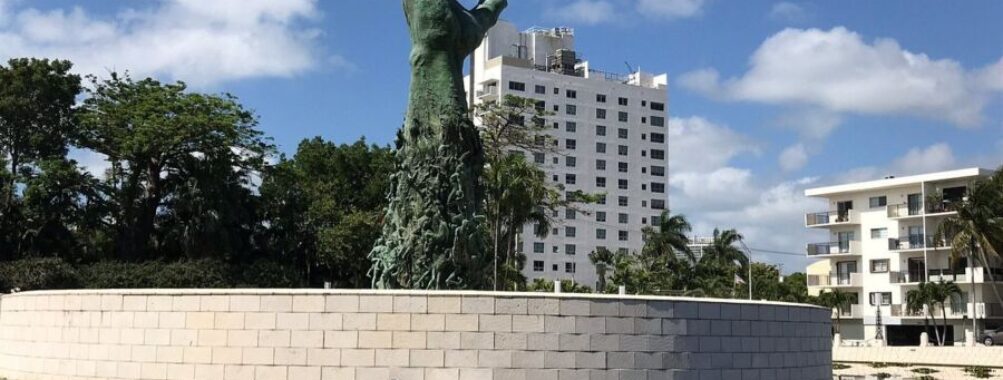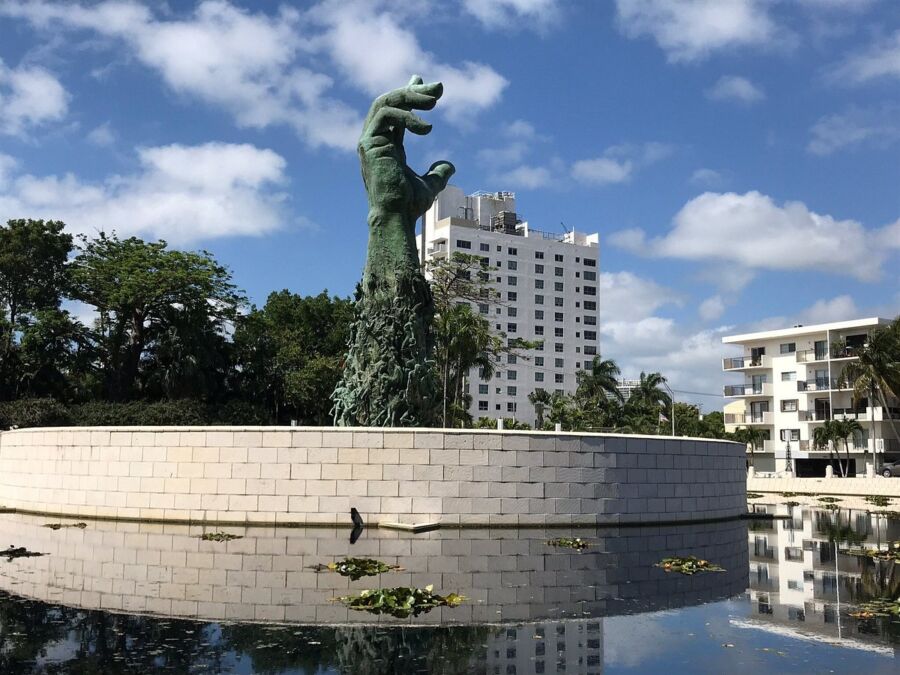
Holocaust Memorial Miami Beach
History and Significance
Establishment of the Memorial
The Holocaust Memorial Miami Beach stands not just as a structure but as a powerful testament to the tragic loss of six million Jewish lives during the Holocaust. Established under the auspices of the Holocaust Memorial Committee in 1980, this memorial is deeply rooted in its purpose to honor and remember the victims. South Florida is home to a significant population of Holocaust survivors, making Miami Beach a fitting location for the memorial. Many survivors found refuge here and they infused the region with their stories of resilience.
A Reminder of Historical Atrocities
The significance of this memorial extends beyond remembrance. It’s a striking reminder of the atrocities committed from 1933 to 1945, urging visitors and future generations to acknowledge the past.
- Educational Purpose: It serves as a vital educational tool to raise awareness about the importance of tolerance and human rights.
- Cultural Impact: Memorializing such a dark chapter in history fosters dialogue about acceptance and the consequences of hate.
This memorial is a serene oasis for reflection and a call for vigilance against oppression in all forms.
Main Attractions and Activities
Overview of the Memorial
Visiting the Holocaust Memorial in Miami Beach is an experience steeped in reflection and reverence. This outdoor memorial surrounds a serene pool of water, creating a calm ambiance that invites contemplation.
What to See
The simplicity of the memorial is its strength, with the following key attractions:
- The Wall of Remembrance: This wall features haunting narratives and testimonials that tell the stories of those lost during the Holocaust. It gives voice to the victims whose lives were tragically cut short.
- Victims’ Names: Thousands of names are inscribed, offering a personal touch to the memorial. It’s a stark reminder that each name represents a unique life and story.
Self-Guided Experience
One of the appealing aspects is that the memorial serves as a self-guided, free outdoor museum.
- Freedom to Reflect: You can take your time, moving at your own pace, encouraging a deeper emotional connection.
Although it may lack the grandeur of other memorials, its profound impact lies in the raw emotions it evokes. You’ll leave feeling both moved and humbled.
Visitor Experience
A Warm Welcome
The Holocaust Memorial Miami Beach invites you to embark on an emotionally enriching journey. Since its dedication on February 4, 1990, this memorial has welcomed over 2.6 million visitors, offering profound insights into the Holocaust’s history and its lasting impact.
Engaging Activities
You’ll find various activities designed to engage visitors of all ages, including:
- Film Screenings: Thought-provoking documentaries and films help educate about this dark historical period.
- Cultural Exhibitions: Rotating exhibitions provide a closer look at the stories and heritage of those affected by the Holocaust.
- Guest Speakers: Hear from Holocaust survivors and historians, bringing you personal narratives and academic perspectives directly.
Educational Opportunities
The memorial also prioritizes educational outreach. More than 300,000 students have walked through its serene grounds, learning about tolerance and the importance of human rights. With its combination of heartwarming stories and educational programming, your visit becomes more than just a day out; it’s a profound journey that will stay with you long after you leave. Whether you come alone or with a group, each experience shapes a greater understanding of history’s lessons.
Tips for Visitors
Planning Your Visit
When you decide to visit the Holocaust Memorial in Miami Beach, preparation can enhance your experience. Here are some essential tips to make the most of your visit:
- Go Early: Visiting early in the day offers a quieter atmosphere, allowing you to reflect peacefully without distractions.
- Allocate Enough Time: While it may seem small, plan to spend at least an hour here. You’ll want to absorb the stories and memorials thoroughly.
Self-Guided Exploration
Embrace the self-guided nature of the memorial. Here are some recommendations:
- Take Your Time: Feel free to wander at your own pace. Engage deeply with the exhibits, reading the narratives on the wall.
- Reflect: Find a serene spot by the tranquil water pool to pause and reflect on the history and emotions you’ve encountered.
Free and Accessible
This memorial is completely free to enter, making it accessible to all.
- A Powerful Message: Remember that this memorial’s impact lies in its simplicity. It may not be extravagant, but it delivers a poignant message.
Visiting the Holocaust Memorial is not only a historical lesson but also a reminder of humanity’s capacity for resilience and reflection. Don’t miss this essential tribute while you’re in Miami Beach.
Accessibility and Facilities
Inclusive Design
The Holocaust Memorial Miami Beach prioritizes accessibility, ensuring every visitor can experience this poignant tribute. With that in mind, it has facilities tailored to accommodate diverse needs.
- Wheelchair Access: The memorial is fully accessible for patrons using wheelchairs. If you require a wheelchair during your visit, simply call 305.538.1663 ahead of time to arrange one.
- ASL Interpretation: Visitors who need assistance with American Sign Language can request an interpreter by calling the same number in advance, enhancing the memorial’s inclusive environment.
Visiting Information
This memorial is a seamless addition to your Miami Beach itinerary:
- Free Admission: Entry is free, allowing everyone to pay their respects without a financial barrier.
- Opening Hours: Open every day from 10:00 am until sunset, you have the flexibility to fit this meaningful visit into your schedule.
Transportation and Parking
While it is conveniently located, remember that limited metered parking is available on Elie Wiesel Way (19th Street). Planning can ease your visit, allowing you to focus on the essential experiences awaiting you at the memorial.
Unique Features
Iconic Artistry
One of the memorial’s most striking elements is the Sculpture of Love and Anguish. This enormous bronze sculpture serves as the centerpiece of the Holocaust Memorial in Miami Beach.
- Symbolic Design: It represents an outstretched arm rising from the earth, reaching toward the heavens. This powerful imagery conveys a message of hope amidst despair, encapsulating the essence of the memorial.
Commemorative Programs
The memorial isn’t just a silent tribute; it actively engages with the community through a variety of programs:
- Educational Outreach: Committed to fostering understanding, it offers lectures, teacher seminars, and school tours, ensuring that all ages can learn about the importance of tolerance and remembrance.
- Special Commemorations: Each year, events are organized to honor significant dates like Kristallnacht and Yom Hashoah, providing a chance for reflection and community engagement.
A Global Landmark
Welcoming over 100,000 visitors annually, this Miami Beach landmark is recognized worldwide. It’s not only about remembrance; it’s an essential part of fostering open dialogue about human rights, making it a unique and vital destination for everyone.
Overall Impressions
A Powerful Experience
Visiting the Holocaust Memorial in Miami Beach leaves a lasting impression. Many who walk through its gates find it a profoundly moving experience, capturing a unique blend of education and reflection.
- Architectural Significance: The memorial’s architecture is nothing short of remarkable. The large hand sculpture, symbolizing lost lives, stands out as a focal point. It evokes strong emotions and serves as a poignant reminder of the Holocaust’s brutality.
- Symbolic Elements: The prominent Star of David positioned near the entrance enhances the memorial’s spiritual aspect, offering visitors a place to contemplate.
A Journey Through History
The memorial’s curved wall pathway is particularly notable.
- Narrative Flow: This pathway guides you through a timeline of events, delivering a comprehensive understanding of the Holocaust’s historical context. It effectively brings the story to life, illustrating its profound impact on local and global communities.
With all these elements combined, the Holocaust Memorial does more than commemorate; it creates a space for understanding the long-lasting effects of hate and the importance of remembrance. It’s a visit you’d want to make time for again and again.
Pros and Cons
Pros
Visiting the Holocaust Memorial in Miami Beach has several standout advantages that make it a worthwhile experience:
- Free Admission: One of the most significant benefits is that entry is free, enabling everyone to explore its profound messages without financial barriers.
- Educational Focus: The memorial serves as a self-guided educational space. It allows visitors to learn about the Holocaust at their own pace, fostering a deeper understanding.
- Simplicity and Power: Unlike some extravagant memorials, this space’s simplicity enhances its impact. Each element, from the architecture to the narratives, is poignant and deeply moving.
Cons
However, there are a few downsides worth noting:
- Limited Amenities: As an outdoor memorial, it may lack some facilities and comforts found in larger museums, which might deter some visitors.
- Size Constraints: While the memorial is powerful, it’s also smaller than other historical sites. For some, this could result in a quicker visit than anticipated.
Despite these cons, the Holocaust Memorial Miami Beach remains an essential stop for meaningful reflection and education, making it a must-visit location in the city.
Location
Places to Stay Near Holocaust Memorial Miami Beach
Find Tours in Golden Glades
Explore More Travel Guides
No reviews found! Be the first to review!
